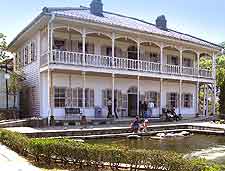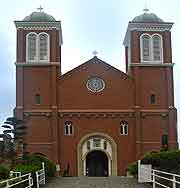Nagasaki History Facts and Timeline
(Nagasaki, Kyushu, Japan)

Founded by the Portuguese during the 16th century, Nagasaki is perhaps most renowned for being the site of the second US atomic bomb in World War II. Originally a fairly insignificant fishing village, Nagasaki was very much off the radar until the year of 1543, when Portuguese explorers landed on the island of Kyushu and began to colonise the best-placed location.
In the early 1570s, Portuguese traders began harbouring ships in Nagasaki and the sleepy fishing village started to grow into a key port town. From here, Portuguese products including tobacco, fabrics and baked goods were all imported and introduced to Japanese society. The town would remain one of Japan's principal windows for foreign trade and influences for the few hundred years ahead.
This early period in Nagasaki history is the most interesting, since it was briefly a Jesuit colony. It escaped efforts by General Toyotomi Hideyoshi to rid Japan of foreign religious influence in the late 16th century, but after discovering a group of missionaries aboard a wrecked ship, he suspected a pretext for Spanish invasion and so began a period of crucifications in the town. Traders were tolerated however, and a change of leadership in Japan in 1603 allowed the English and the Dutch to settle without any religious strings attached.
The Meiji Period
After a period of unrest and a ban on overseas dealings, the Meiji Restoration (Imperial Restoration) saw Japan reopen its ports to diplomatic relations and international trade. In 1859, Nagasaki was declared a free port and the decade that followed witnessed many improvements to the infrastructure of the town.
This busy port town officially became a city in 1889. During this period, Nagasaki also developed into a major industrial hub. The building of ships soon served as a mainstay of the city's economy, with its dockyards being extensively used by the Imperial Japanese Navy, and its harbour being controlled by the Sasebo Naval District. It was partly for this reason that Nagasaki suffered one of the biggest catastrophes in Japan's history.
Atomic Bomb
On 9th August 1945, the city was struck by an atomic bomb, nicknamed the 'Fat Man', which was dropped by the US just three days after the bombing of
Hiroshima. This plutonium bomb was dropped at around 11:00 in the morning and proceeded to obliterate everything to the north of Nagasaki, killing somewhere in the region of 70,000 Japanese. A similar number suffered injuries and more than 300,000 were left with diseases or direct side-effects of the lasting radiation, slowly dying as a result of the fallout and other radiation-related illnesses. The effects of this terrifying new warfare technology were decisive and within days, the Imperial Japanese Army had agreed to a surrender, thus ending the Pacific WWII.

The Recovery
Following the war, Nagasaki was slowly reconstructed, although little in the destroyed parts resembled the city of old. New temples soon graced the streets of the city, and churches were built to meet the needs of the increased amount of people practising Christianity here.
Much of Nagasaki's history was sadly wiped out by the bomb, but some of the debris remains as a poignant memorial to this day, including an archway erected close to ground zero and a simple torii gate. The renowned Atomic Bomb Museum was opened in the mid-1990s, around 50 years after the bombing, and offers an extensive history of the war and nuclear weapons in general, with audio-visuals, photographs and related documentation. Of note, you will find the Nagasaki International Peace Memorial Hall right next-door.
More recently, in 2005, the city expanded its boundaries to incorporate a number of suburb towns, such as those of Nomozaki, Sanwa and Sotome. The city is still a major port and supports a thriving shipping industry, as well as experiencing an influx of tourists due to its unusual historical significance.
 Founded by the Portuguese during the 16th century, Nagasaki is perhaps most renowned for being the site of the second US atomic bomb in World War II. Originally a fairly insignificant fishing village, Nagasaki was very much off the radar until the year of 1543, when Portuguese explorers landed on the island of Kyushu and began to colonise the best-placed location.
Founded by the Portuguese during the 16th century, Nagasaki is perhaps most renowned for being the site of the second US atomic bomb in World War II. Originally a fairly insignificant fishing village, Nagasaki was very much off the radar until the year of 1543, when Portuguese explorers landed on the island of Kyushu and began to colonise the best-placed location.